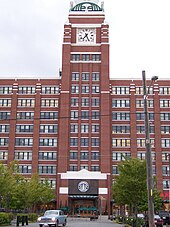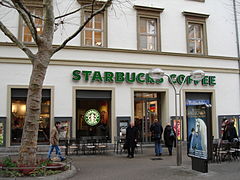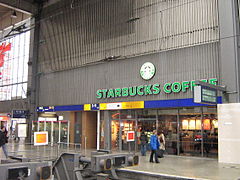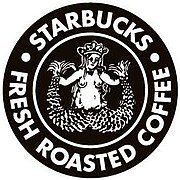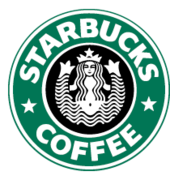Starbucks
| Starbucks Corporation
|
|
|---|---|
| legal form | Corporation |
| ISIN | US8552441094 |
| founding | March 31, 1971 ( Seattle ) |
| Seat |
Seattle , Washington , United States |
| management |
|
| Number of employees | 291,000 |
| sales | 24,720,000,000 USD |
| Branch | Quick service system catering |
| Website | www.starbucks.com |
| As of October 1, 2018 | |
Starbucks Corp. ( NASDAQ : SBUX) is an international coffee products retailer and franchisor headquartered in Seattle , United States . Starbucks buys, roasts and sells coffee beans through the Group's own licensed self-service cafes (30,000 in total) in 80 countries (as of June 30, 2019).
History of the company
founding
In April 1971, college friends Gerald Baldwin, Gordon Bowker and Zev Siegl from San Francisco opened the coffee, tea and spice shop "Starbucks Coffee, Tea and Spice" in the old port of Seattle at Pike Place in 1912 . They chose the name based on the helmsman Starbuck from Herman Melville's novel Moby Dick . By 1981 another three branches were opened in Seattle.
Schultz joins the company
In 1982, Howard Schultz became head of retail and marketing at Starbucks. First, he expanded the business to supply upscale restaurants and espresso bars with coffee beans. A visit to a sales fair in Milan in 1983 gave him the idea of selling beans as well as offering prepared coffee for on-site consumption. In 1984 the owners gave him the right to set up small espresso bars in the shops. The coffee bar concept proved successful, although further expansion was rejected because, according to Baldwins, Bowkers and Siegls, the hobby should always take precedence over the business. This ultimately led to the break in the business relationship. Schultz quit Starbucks and opened his own coffee bar called Il Giornale in 1985 , with the support of his previous employers. After finding investors, he was able to make a compelling takeover offer to his previous employers and coffee connoisseurs . In 1987 he bought Starbucks for $ 3.8 million and began expanding with 11 stores and 100 employees. In the course of the ministerial conference of the economics and trade ministers of the WTO in Seattle in 1999 riots broke out and Starbucks branches were damaged, which was met with incomprehension in the management, as Howard Schultz saw himself as socially oriented.
Expansion and further development
In 1989 Schultz had quintupled the number of its stores to 55, mostly on the west coast and in Portland , Oregon . In 1992 Starbucks was converted into a public company. The common stock has since been traded on the NASDAQ National Market under the symbol "SBUX". With the money from the IPO, the branch network could be expanded; Starbucks was soon represented in 272 locations.
In 1994/95 the west coast and the Gulf of Mexico were reached, with a total of 676 locations across the US.
From 1996 the first locations followed in Japan , Singapore and the Philippines and up to 2000 branches in the United Kingdom , the Republic of China (Taiwan) , Thailand , New Zealand , Malaysia , the People's Republic of China , Kuwait , South Korea , Lebanon and the United Arabs Emirates , Qatar , Bahrain , Saudi Arabia and the first branches in Australia .
In 1999 Starbucks bought the tea manufacturer Tazo . In addition, a contract was signed with Thermoplan for the exclusive delivery of the coffee machines. In 2000, at 3,500 locations worldwide , Schultz withdrew from the operative business and moved to the supervisory board.
2001/2002 branches opened in Switzerland and Austria . In Germany, Starbucks entered into a joint venture with KarstadtQuelle AG , KarstadtCoffee GmbH. The expansion continued with coffee houses in Turkey , Chile and Peru to 7,225 locations worldwide. In 2003, 7,000 cafes were owned by Starbucks. In 2004/2005 Starbucks' German partner Arcandor ran into financial difficulties, whereupon KarstadtCoffee GmbH was taken over by the American parent company.
In a publicly known memo from Schultz to top management in February 2007, he complained that "romance and drama have disappeared," the stores have lost their soul. The full mechanization of the brewing process, long queues and sandwiches instead of muffins, according to him, drove Starbucks customers to compete. On January 8, 2008, Schultz returned as CEO and initiated a reorganization and a new market development strategy. In the United States, 600 branches were closed and up to 12,000 part-time and full-time jobs were cut. In the 2015 financial year, the coffee shop chain had sales of around 19.2 billion US dollars.
In December 2016, the company announced that Schultz would retire from management in April 2017 and hand over the position of CEO to the previous COO Kevin Johnson . Schultz was to stay with the company in another role.
In February 2017, the company announced that it would build a second roasting plant in Milan in Europe in addition to the roasting plant in Amsterdam, which had been in existence since 2003, and entering the Italian market with several branches.
In November 2017, Starbucks sold its tea brand Tazo to Unilever for $ 384 million .
In May 2018, the Swiss Nestlé group took over the global marketing rights for products such as beans and ground coffee from the producer Starbucks for 7.15 billion US dollars. This does not affect finished beverages and the sale of all products in Starbucks cafes. This corresponds to roughly 3.5 times the previous annual turnover.
In June 2018, Starbucks announced the departure of Howard Schultz from the company's management. In the same year Starbucks was represented with 28,000 cafes in 75 countries.
- Branches
Branch, Munich Central Station
Seoul , South Korea
Companies
Company logo
The logo has been changed several times over the years. In the beginning the siren was topless. In the second version, hair covered the breasts, but a navel was still visible. In the version from 1992 this is no longer visible either. Since 2011 the company name has been omitted, the siren alone forms the logo.
- Logos
Products
The chain’s standardized range of products primarily includes coffee products. A range of coffee beans is also sold. The products are generally made from dark roasted Arabica coffee beans. Starbucks also sells several music CDs under its own label. Cakes and pastries are partly sourced directly from the USA for the target markets. Starbucks guests can also choose from a variety of milks or alternatives, including low-fat milk, lactose-free milk and soy milk .
In addition to its own creations, Starbucks offers well-known things such as normal filter coffee, caffè latte , cappuccino or espresso . There are also variations of these coffee beverages, such as caramel macchiato, caffé mocha and white caffé mocha, as well as ice-cream beverages (frappuccino), which have a coffee (“blended coffee”) or milk base (“blended cream”) with crushed ice and various Flavors is processed into a cold drink. Fruit juices such as raspberry and mango juice are combined with tazo tea and crushed ice to make "blended juice drinks".
Since September 2012, Starbucks has been offering a one-cup coffee machine for espresso, caffè latte and filter coffee under the name “Verismo”.
Nutritional values
The initiative "Action on Sugar", in which experts in health and nutrition test foods for their sugar content , published the results of a study in February 2016, according to which the product "Hot Mulled Fruit - Grape with Chai, Orange and Cinnamon - Venti" the amount of sugar from contains about 25 teaspoons . The amount of sugar served per unit of consumption would be 99 grams . This makes it the most sugary drink of the 131 products examined. In the ranking Starbucks products occupied also ranked 3 and 4: "White Chocolate Mocha with Whipped Cream - Venti" contains 73.8 g of sugar, "Signature Hot Chocolate - Venti" even 60 grams (equivalent to 18 or 15 teaspoons). Action on Sugar spoke of a "scandalous crowd".
"These results highlight the need for more transparency on sugar content and compulsory labeling of sugar content."
"These results emphasize the need for more transparency and mandatory labeling with regard to the sugar content."
In contrast, Starbucks relied on nutritional tables that had already been published in the shops and emphasized that the range also contained products with a lower sugar content.
Branches
Starbucks is present on several continents and is one of the best-known brands in the world, comparable to McDonald’s . In 2018 there were over 29,000 Starbucks coffee shops worldwide, of which 15,341 were operated by the company itself and 13,983 as a franchise. As of May 2014, most Starbucks branches worldwide are located in the South Korean capital, Seoul .
Starbucks in Germany
The first two Starbucks branches in Germany opened in Berlin in May 2002 . In 2016 Starbucks had 158 branches in Germany, including 144 own shops and 14 coffee houses under the franchise companies New Vision, SSP Germany and Marche.
They are all operated directly by AmRest Coffee Deutschland Sp. Z oo & Co. KG, based in Munich , which operated as Starbucks Coffee Deutschland GmbH until April 2016 and was based in Essen until May 2012. The German Starbucks branches previously belonged to 82 percent of the department store group KarstadtQuelle , which sold its stake in Starbucks in November 2004 due to the crisis. In April 2016 it was announced that Starbucks Germany had sold 100 percent of its shares to the Polish company AmRest for around 41 million euros.
Starbucks in Austria
The coffeehouse chain is represented in Austria with 18 branches (as of June 2016), these include 14 branches in Vienna , 3 branches in Salzburg , and one in the Shopping City Süd (city: Vösendorf ). The first branch in Austria was opened on December 8th, 2001 in Vienna's Kärntner Strasse. That branch was closed on June 12, 2016. According to the company, the location - with a rumored monthly rent of around 25,000 euros - has become unprofitable and also needed renovation.
Starbucks in Switzerland
Starbucks has had 62 branches in Switzerland since 2001 (as of April 2018). Of these, 16 branches are in the city of Zurich alone , as are 9 branches in Geneva and 4 branches each in Basel and Bern and 29 in the rest of Switzerland. The Starbucks branch opened in March 2001 at Zurich Central was the group’s first branch in continental Europe. Because of its cultural diversity , the company used Switzerland as a test market .
As part of a nine-month trial, starbucks in cooperation with Elvetino November 21, 2013, present a double-deck dining car of the SBB on the route St. Gallen - Geneva. In contrast to other branches, full meals were offered. Soft drinks and alcoholic beverages were no longer available. Service took place on the upper floor, self-service and bar tables in the basement, operated by up to 4 employees. The SBB put the cost of converting the first vehicle at 1.6 million francs. Starbucks coffee is now available in all regular SBB dining cars. The basic concept of the Starbucks dining car, however, was not pursued any further and was instead integrated into the new SBB concept.
In March 2020, Starbucks Switzerland ceased operations until further notice due to the COVID-19 pandemic .
Starbucks in China
In 2018 Starbucks had 3,000 branches in China, 600 and the world's largest in Shanghai with 2,700 m². A new Chinese branch was opened every 15 hours in 2018.
Business practices
When opening new branches, choosing a location with a high proportion of walk-in customers (airports, train stations, shopping centers or centers in large cities) as well as large-scale entry into national markets, often in cooperation with national companies such as KarstadtQuelle in Germany, is key. After successfully positioning itself in the market, Starbucks often separates from the cooperation companies, and these are often also taken over, for example by the Seattle Coffee Company in Great Britain or Sazabys in Japan. The product names, which are often made up, are mostly in-house creations in a mixture of primarily English and Italian , with some French terms also being used . This goes hand in hand with the designation of the employees as baristas , actually an Italian job title for service personnel who prepare espresso . Customers are asked for their first name so that they are not called up with the number of the order if their drink cannot be served over the counter immediately. Regular customers know this from the staff in the local cafe. In some cases, rental contracts for cafes are taken over from competitors by negotiating with the landlord before extending them. Libraries and downtown New York, where the branch density is highest, are carefully selected branch locations. The target customers are conveyed that the coffee of this brand is an affordable prestige of high society, that 99% of the coffee beans bought come from fair trade and that the consumption is intellectually compatible with the refusal of consumption of the 68 movement . Square tables are avoided in the furnishings of the cafes, the aim is to be a third place for the customer .
Business data
In 2014 Starbucks was represented in over 65 countries with 20,519 own and licensed coffee houses. In 2013, Starbucks had annual sales of $ 14.89 billion with over 182,000 employees worldwide. By 2017, the number of employees rose to 277,000 and sales to $ 22.39 billion. In the same period, the profit could be increased from 8 million to 2.9 billion US dollars.
Despite the increasing number of stores, Starbucks had to announce a decline in customer numbers in the USA for the first time on November 15, 2007.
Starbucks stock first traded at $ 17 in June 1992, peaking at $ 39.63 on May 5, 2006, and slipping 48 percent to $ 19.31 by January 2, 2008 . After that, the stock rose with minor interruptions and exceeded $ 80 for the first time in 2012. In 2013, the share peaked at $ 82.50. In October 2018, the company's market value was approximately $ 78 billion.
6.34% of the shares are owned by the Vanguard Group and 5.91% are owned by BlackRock , the remainder is in free float.
| year | Employees | Sales in US $ million |
Balance sheet profit in million US $ |
|---|---|---|---|
| 2010 | 137,000 | 10,707 | 946 |
| 2011 | 149,000 | 11,700 | 1,246 |
| 2012 | 160,000 | 13,277 | 1,384 |
| 2013 | 182,000 | 14,892 | 8th |
| 2014 | 191,000 | 16,448 | 2,068 |
| 2015 | 238,000 | 19.163 | 2,757 |
| 2016 | 254,000 | 21,316 | 2,818 |
| 2017 | 277,000 | 22,387 | 2,885 |
| 2018 | 291,000 | 24,720 | 4,518 |
| 2019 | 346,000 | 26,509 | 3,599 |
digitalization
In many countries, free internet access is offered via WLAN , which Starbucks is implementing in cooperation with British Telecom , for example . In addition, the company was one of the first service providers to enable mobile payment via smartphone. In particular, Starbucks was a pioneer in helping Apple's Passbook .
criticism
Trade in coffee producers
A legal battle between Ethiopian coffee farmers and Starbucks in 2007 weighed on Starbucks' reputation as a fair trading partner. Starbucks pays the farmers an above-average price, but the Ethiopian farmers wanted to have more control over sales and thus an even higher price by legally protecting the name of the growing region as the Sidamo trademark . Starbucks, however, did not want to sign a license agreement and initiated an objection to the name protection through the National Coffee Association of USA (NCA). A close connection to the NCA existed through Dub Hay, Vice President of Starbucks and responsible for global purchasing, who also acted as a lobbyist for the NCA. The NCA had initially achieved through legal objection that the patent office rejected the Ethiopian application. As a result of the impending loss of reputation, however, Starbucks recognized the three Ethiopian coffees Sidamo, Harar and Yirgacheffe as trademarks in June 2007 and signed a license, sales and marketing agreement.
Starbucks states that it purchases its coffee "fairly" and, through its own project "CAFE (Coffee and Farmer Equity) Practices", practices paying a price that is above the market, taking into account qualitative, economic, ecological and social criteria, developed by coffee farmers and sustainability experts and employees of "Conservation International" (CI). CAFE was founded independently in 2000 and later dropped out of direct negotiations with Starbucks. CI mediates to the purchasing departments of various corporations. This would support humanitarian projects, such as “CSR projects” at schools run by the Fundraising Akademie gGmbH .
Anti-union corporate policy
Critics like Naomi Klein , author of No Logo , accuse the company of fighting cut-throat competition at the expense of local businesses and the employees at Starbucks. The international union IWW called for a boycott of Starbucks in August 2006 after four of its members who belonged to the IWW Starbucks Workers Union were terminated. By the end of 2006, the number of those terminated increased to five IWW members.
In April 2007, the National Labor Relations Board ( NLRB ) brought 30 cases against Starbucks at the instigation of the IWW. It dealt with alleged anti-union practices, unfair actions against employees and dismissals under supposedly fabricated pretexts. The trial began in New York in August 2007 and continued in early 2008.
In March 2008, the company was sentenced to return approximately $ 100 million of withheld tips to employees. Since 2004, an employee had brought a class action lawsuit against the practice of involving supervisors in Starbucks shops in tipping their employees.
The author Günter Wallraff wrote in 2009, after “research behind the in-facade of the Starbucks coffee house chain”, that “inhumane conditions” prevailed there.
In German branches, works councils are specifically elected according to specifications and under pressure from management. According to the food-enjoyment-restaurants union, these alleged employee representatives are not loyal to their colleagues but to management. Works councils that are actually independent are harassed with false accusations and warnings and forced to give up their jobs.
Tax avoidance
Starbucks uses strategies such as Double Irish With a Dutch Sandwich as part of its international tax planning to reduce its corporate tax burden. Various non-governmental organizations and politicians criticize this practice. As a consequence, Starbucks announced in April 2014 that it would relocate its European headquarters from Amsterdam to London and thus pay more taxes in the United Kingdom, where more than half of all European branches are located with 800 branches, which in 2012 was a tax avoidance in the press was. Starbucks had paid license fees to itself at Starbucks EMEA in the Netherlands, where taxes were lower. The European Union fined Starbucks in October 2015 to pay up to 30 million euros. The European Commission came to the conclusion that tax rulings (see also Luxembourg Leaks ), which artificially reduce a company's tax burden, are illegal. EU state aid rules are violated as Starbucks has been granted an illegal competitive advantage over other coffee houses. Both Starbucks and Luxembourg are defending themselves against the verdict and insisting that they have not violated any OSCE rules. It is not known if Starbucks will change its declared illegal tax practice in the future. On September 24, 2019, the General Court of the European Union (CFI) ruled that Starbucks had not received any illegal tax breaks in the Netherlands.
Waste problem
For many years, the amount of garbage has been criticized, especially by the disposable cups. Starbucks counteracts this with the fact that customers can have the drink filled into their own cup they have brought with them. Attempts to recycle have so far failed.
literature
- Howard Schultz, Dori Jones Yang: The Starbucks Success Story. Signum, Hamburg / Vienna 2003, ISBN 3-85436-314-1 . (Translation of Pour Your Heart Into It. How Starbucks Built a Company One Cup at a Time. Hyperion Books, New York, NY 1999, ISBN 0-7868-8356-1 )
- Naomi Klein: No Logo! The struggle of global players for market power. A game with many losers and few winners. Goldmann Verlag , Munich 2005, ISBN 3-442-15312-3 , pp. 152-156.
- Constanze Ullmann: Internationalization of coffee shops. Market development strategies between fast food and feel good. VDM Verlag Dr. Müller, Saarbrücken 2006, ISBN 978-3-86550-244-5 (Diploma thesis, Wiesbaden University of Applied Sciences 2004, 136 pages, under the title: International market development using the example of coffee shops ).
- Joseph A. Michelli: The Starbucks Secret. How coffee becomes gold. Redline Wirtschaftsverlag, Munich 2008, ISBN 978-3-636-01560-0 .
- Howard Schultz, Joanne Gordon: Onward: How Starbucks successfully struggled to survive without losing its soul. VCH-Wiley, Weinheim 2011, ISBN 978-3-527-50635-4 .
Web links
- Official Starbucks international website
- IWW Starbucks Workers Union (English)
- Starbucks Unfiltered - The Bitter Truth Behind Success , Arte , August 28, 2018
- https://www.xn--untergrund-blttle-2qb.ch/wirtschaft/unternehmen/starbucks_am_anfang_war_die_gegenkultur_4971.html
- Press article
- More spirit, fewer customers - the financial crisis in the US is apparently damaging Starbucks' businesses. Union activities also cause problems for the group. In: jungle world . January 24, 2008
- The baristas and the leaders - The syndicalist IWW organizes precarious Starbucks workers. In: analysis & criticism . December 15, 2006, no.512
- The coffee king. In: The time . April 16, 2003, no.17
Individual evidence
- ↑ https://www.starbucks.com/about-us/company-information
- ↑ corporate governance , on www.investor.starbucks.com, accessed on November 3 2,017th
- ↑ a b c Starbucks: Annual Report 2018. (PDF) Retrieved on March 26, 2019 (English).
- ↑ https://www.starbucks.com/about-us/company-information/starbucks-company-profile
- ↑ https://www.starbucks.com/about-us/company-information/starbucks-company-profile
- ↑ Erik Neu: The Concise and Correct Explanation of the Starbucks Naming Myth. ( Memento of May 14, 2009 in the Internet Archive ) February 27, 2006.
- ↑ a b c d e f arte TV (ed.): Starbucks unfiltered . 2018.
- ↑ Disappeared romance at US coffee house chain. In: WirtschaftsWoche . March 6, 2007.
- ↑ Starbucks cuts 600 jobs in the USA. In: The press . February 22, 2008.
- ↑ Starbucks closes unprofitable US branches. ( Memento from February 10, 2009 in the Internet Archive ) In: Süddeutsche . July 2, 2008
- ↑ Starbucks: Annual Report 2015. (PDF) Accessed April 24, 2016 (English).
- ↑ Starbucks boss Schultz relinquishes management. In: rp-online.de. Retrieved December 2, 2016 .
- ↑ Starbucks boss resigns. In: nzz.ch. Retrieved December 2, 2016 .
- ↑ n-tv.de
- ^ Starbucks Company Timeline. Starbucks, accessed June 5, 2018 .
- ↑ a b Nestlé buys Starbucks retail store - manager magazin . In: manager magazin . ( manager-magazin.de [accessed on May 9, 2018]).
- ↑ Swiss people sell billions in marketing deal: Nestlé wants to earn even more money in Germany with Starbucks coffee , Manager-Magazin , 23 August 2019
- ↑ Winand von Petersdorff: Howard Schultz: The Starbucks founder withdraws. In: www.faz.net. June 5, 2018, accessed June 5, 2018 .
- ↑ Starbucks Siren Takes It All Off ( January 8, 2007 memento in the Internet Archive )
- ↑ Heinz Insu Fenkl: The Mermaid. Endicott Studio, 2003, archived from the original on January 2, 2014 ; accessed on February 2, 2017 .
- ^ Robert Levine: Would You Like an Extra Shot of Music With That Macchiato? In: The New York Times . November 3, 2004.
- ↑ a b actiononsugar.org ( Memento of 19 February 2016 Internet Archive ), Action on Sugar - Website, February 17, 2016. Retrieved on February 18 2016th
- ↑ Cities with the largest number of Starbucks stores worldwide as of May 2014. In: Statista . Retrieved October 21, 2018 .
- ↑ David Yanofsky: A cartographic guide to Starbucks' global domination. In: Quartz . May 27, 2014, accessed October 21, 2018 .
- ↑ a b Starbucks Extends Licensing Agreement with AmRest to Grow Stores in Germany In: Starbucks Newsroom. April 20, 2016. Retrieved April 20, 2016.
- ↑ Starbucks moves to Munich . In: Frankfurter Allgemeine Zeitung . August 29, 2011, ISSN 0174-4909 ( faz.net [accessed March 15, 2012]).
- ↑ Starbucks imprint. accessed on January 2, 2017.
- ↑ Starbucks takes over Karstadt Coffee GmbH. In: Handelsblatt. January 3, 2005, accessed July 23, 2013.
- ↑ starbucks.at ( Memento of the original from April 25, 2014 in the Internet Archive ) Info: The archive link was inserted automatically and has not yet been checked. Please check the original and archive link according to the instructions and then remove this notice.
- ^ Salzburg City: Starbucks opens at Hagenauerplatz. In: Salzburger Nachrichten. 3rd September 2013.
- ↑ Boiled up: Starbucks closes the Vienna flagship store on June 9, 2016
- ↑ John J. Wild, Kenneth L. Wild, Jerry CY Han: International Business - The challenges of globalization . 5th edition. Prentice Hall (Pearson Education), Upper Saddle River (New Jersey) 2010, ISBN 978-0-13-715375-6 , pp. 325 .
- ↑ World premiere: Starbucks on rails. ( Memento from November 22, 2013 in the Internet Archive )
- ↑ Rolling Starbucks branch on the SBB network. In: Eisenbahn-Revue International . 1/2014, p. 14f.
- ↑ SBB: Less Starbucks, more beer In: handelszeitung.ch , September 28, 2016, accessed on April 15, 2018.
- ↑ globalassets.starbucks.com
- ↑ Starbucks annual figures investor.starbucks.com ( page no longer available , search in web archives ) Info: The link was automatically marked as defective. Please check the link according to the instructions and then remove this notice.
- ↑ a b c https://www.starbucks.de/coffeehouse/wireless-internet
- ↑ Starbucks Falls Most in 17 Months After Stock Rating Is Lowered ( Memento from September 10, 2012 in the web archive archive.today ), Bloomberg, January 2, 2008
- ↑ finanzen.ch
- ↑ Starbucks Market Cap 2006-2018 | SBUX. Retrieved October 21, 2018 .
- ↑ Starbucks Balance Sheet, Profit and Revenue | Starbucks Annual Report | 884437. Retrieved October 21, 2018 .
- ↑ Moritz Stückler: Passbook : Pay for Starbucks coffee when entering a shop. (No longer available online.) In: t3n magazine . October 4, 2012, archived from the original on October 6, 2012 ; Retrieved October 4, 2012 .
- ↑ Tagesschau "Starbucks: A coffee company fears for its image" Tagesschau , March 7, 2007. ( online article no. 80 )
- ↑ Starbucks prevents Ethiopia's coffee farmers from doing better: Oxfam calls on the coffee company to sign a license agreement for coffee names. In: Oxfam . March 7, 2007.
- ↑ Resources: black and strong. In: Spiegel online . June 5, 2007.
- ↑ Oxfam welcomes Starbucks to give in to Ethiopian coffee brands. In: Development Policy Online. June 22, 2007.
- ↑ Cooperation with non-profit organizations from a corporate perspective - Corporate Social Responsibility at Starbucks ( Memento from February 1, 2012 in the Internet Archive ) norddeutscher-fundraisingtag.com accessed April 1, 2008.
- ↑ N. Klein: No Logo. HarperCollins, London 2000, p. 136 ff.
- ↑ Resignations for Union Activity: International Protests Against Starbucks. iww.org
- ^ Icy Day Finds Old Union Outside Modern City Shops. In: The New York Times. January 22, 2008.
- ↑ Starbucks must tip employees. In: Spiegel-Online. March 21, 2008.
- ^ Günter Wallraff: New Wallraff book is a journey into the social desert. Focus Online, pp. 1, 8 , accessed December 1, 2009 .
- ↑ REPORT / 002: Gerhard Zwerenz and Günter Wallraff read at the literature festival in Leipzig (SB). In: Schattenblick. MA-Verlag, accessed on December 1, 2009 : "... - as well as research behind the in-facade of the Starbucks coffee house chain, which he attests to have sect-like structures that make their company" family ", brainwashing" further training "and the employees and workers" partners " and they "squeeze until it is no longer possible" ... "
- ↑ Video Frontal 21: Starbucks - "Lousy Methods in the Coffee House" (December 14, 2010) in the ZDFmediathek , accessed on November 3, 2011. (offline)
- ↑ Video today: "How Starbucks deals with employees" (November 14, 2011) in the ZDFmediathek , accessed on November 3, 2011. (offline)
- ↑ Marianne Haas, Silvia Liebrich: Wrong sock color? Warning! Retrieved December 21, 2019 .
- ^ Edward D. Kleinbard: Through a Latte, Darkly: Starbucks's Stateless Income Planning USC Gould School of Law. 15th July 2013.
- ↑ How Starbucks Avoids Taxes. In: Handelsblatt.de. Handelsblatt publishing group , November 2, 2012, accessed on February 16, 2014 .
- ↑ Axel Troost: Companies can continue to use tax tricks. In: linksfraktion.de. Left Group , December 30, 2013, accessed January 2, 2017 .
- ^ David Jolly: Starbucks to Move European Offices to London . In: The New York Times. April 16, 2014, accessed April 16, 2014.
- Jump up ↑ Die Zeit, tax breaks for Starbucks and Fiat are illegal , October 21
- ^ Tageblatt Luxemburg, Luxemburg examines objection ( memento of June 5, 2016 in the Internet Archive ), October 21, 2015
- ↑ ZEIT ONLINE: European Court of Justice: Starbucks received no illegal tax benefits . In: The time . September 24, 2019, ISSN 0044-2070 ( zeit.de [accessed November 5, 2019]).
- ↑ https://www.welt.de/wirtschaft/article203117508/Starbucks-Warum-der-Kaffee-im-Pappbecher-nun-teurer-wird.html
- ↑ https://www.wiwo.de/technologie/green/neues-konzept-starbucks-testet-recycling-becher/13906370.html
- ^ SZ meeting .

